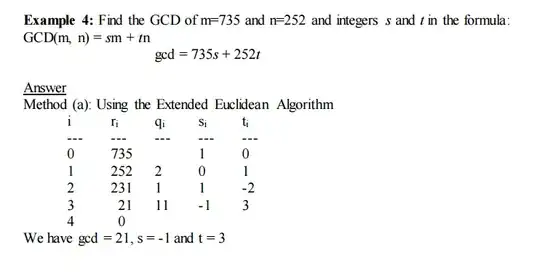I understand everything except the values in $s_i$ and $t_i$ how do we get those values??? Can anyone please elaborate. I have no idea what the formula is for calculating the values in $s_i$ and $t_i$..

Asked
Active
Viewed 189 times
1
Yusha
- 1,631
-
2See this answer. – Bill Dubuque Apr 08 '15 at 22:44
-
Bill I read your explanation. It's great but I mean what is the trick for getting the $s_i$ and $t_i$ is there a trick? Or are you just supposed to guess what numbers to solve the equation? – Yusha Apr 08 '15 at 23:55
-
1The point is that we want to continually keep track of how the $, r_i,$ can be expressed as a linear combination of $735$ and $252$. In your notation this is the equation $\ r_i = 735, s_i + 252, t_i.\ $ I highlight this by explicitly writing the equations in the linked answer. – Bill Dubuque Apr 09 '15 at 00:05
-
1As I explain there, you can view the extended algorithm as the euclidean algorithm extended to the entire equation, i.e. instead of performing the Euclidean operations on the $,r_i,,$ you do it on the whole equation $, r_i = a s_i + b t_i,$ or, equivalently, on their coefficients = row $,[r_i, s_i, t_i]\ \ $ – Bill Dubuque Apr 09 '15 at 00:12
-
I understand that Bill, I'm just trying to grasp how I am supposed to just GUESS that -31 * something will give me my equation on the left. I mean especially if I have HUGE numbers, luckily this problem was FAIRLY easy to guess. But I mean $-36$ as a $s_i$ value just seems kind of crazy to guess. I mean I started off by making a list of $m$ and multiplying by 2, then 3, then 4.. etc .. See my dilemma? Am i missing the point? – Yusha Apr 09 '15 at 00:37
-
You know, suppose I have $124,567 = n(34567) + (23456)m$ , how in the hell am I going to just guess that? I mean i'm just going to have to brute force it out right? – Yusha Apr 09 '15 at 00:38
-
Please point to a specific line in your example or mine and tell me which numbers you don't know how to compute. – Bill Dubuque Apr 09 '15 at 00:45
-
For example, in your example, you have $2 = 7(80) - 9(62)$ which means yours $s_i = 7$ and your $t_i = -9$. Are you just that good at solving equations or is there a special formula or trick you used to obtain those two values. I could of got those but it would of took me at least 20 minutes of trial and error just plugging in numbers to guess what would turn out to satisfy our linear equation $=2$ ... Does that make sense? Like I would have never have guessed those numbers to solve the equation is what I'm saying. Do I just need to get better at math? Or is there a shortcut? – Yusha Apr 09 '15 at 00:57
-
1As notated on the left, that 5th row is simply the result of the following linear combination of the prior two rows: $,{\rm row}_5 = {\rm row}_3 \color{#c00}{- 2}\ {\rm row}_4,,$ i.e below, where $,a,b = 80,62,$ there $\tag{}$ $\qquad \begin{align} 18 =&\quad\ \ 1\cdot a - 1\cdot b\qquad \rm row_3\ \color{#c00}{-2},(8 =&, -3\cdot a + 4\cdot b)\qquad!! \rm row_4\ \Rightarrow\ 2 =&\quad \ \ 7\cdot a + 9 \cdot b\qquad \rm row_5 \end{align}$ $\tag{}$ – Bill Dubuque Apr 09 '15 at 01:21
-
Oops, that should be $,-9\cdot b,$ above. – Bill Dubuque Apr 09 '15 at 01:29
-
Bill I finally understand it. My god I don't why that was so hard to wrap my head around. Thanks for your patience and help. – Yusha Apr 09 '15 at 01:40
-
Great! Please let me know what was unclear so I can improve the exposition. – Bill Dubuque Apr 09 '15 at 01:48
-
Your rows are messed up in your explanation on the other page you are saying row 2 is the very bottom row and row 1 is aboev it?? – Yusha Apr 09 '15 at 02:26
-
row1 is the first (top) row. row2 is the row immediately below row1, etc. – Bill Dubuque Apr 09 '15 at 02:29
-
I get it now. Here is what I was struggling with - the fact that $t_2 = s_1-(q_1t_1)$ similarly, $s_2 = t_1 - (q_1s_1)$ – Yusha Apr 09 '15 at 02:38
-
When I teach this I always teach the equations version first, since then it is clearer what scaling and adding equations means. The row operations are not as intuitive to someone who has not yet met them in linear algebra. Unfortunately it is often taught as a rote tabular algorithm with no explanation of what the tables mean. It is best to think of it as the Euclidean algorithm with the remainders annotated by equations giving their linear reps. Any operation you perform on a remainder must also be extended also to their linear reps in order to propagate the reps to every remainder. – Bill Dubuque Apr 09 '15 at 02:47
-
here is what I was looking for: $s_i = s_{i-2} - (s_{i-1} * q_{i-1})$ – Yusha Apr 09 '15 at 04:37
-
I thought you knew that already. Again, it's easier using entire rows than the individual entries. Write the $i$'th row as $\ R_i = [r_i, s_i, t_i].\ $ Then the row recursion is $\ R_{i+1}= R_{i-1}-q_{i} R_{i}.,$ And its even clearer when the rows are written in equation form $\ , r_i = a s_i + b t_i\ $ vs.$\ [r_i, s_i, t_i].\ $ – Bill Dubuque Apr 09 '15 at 16:37